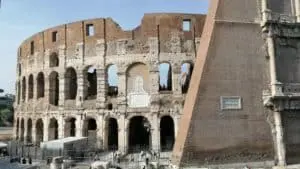Ogham Stones and Ancient Messages: Deciphering the Secrets of Early Irish Inscriptions

Updated On: April 24, 2024 by Noha Basiouny
Ogham Stones are a remarkable testament to the early medieval period in Ireland, marking the landscape with their silent messages from the past. These stones, often discovered in rural landscapes, carry the enigmatic Ogham script—the earliest form of writing in Ireland. The Ogham alphabet is unique, consisting of a series of carved notches and lines that may at first glance seem like simple markings but are in fact a sophisticated system of communication.
Each inscribed stone tells a story, be it the marking of territory, the commemoration of individuals or the recording of inheritances. The intricate details of these carvings allow us to connect with the linguistic and cultural heritage of the Celtic world. Understanding Ogham goes beyond mere translation; it opens a window into the socio-political structure of ancient Irish society and the broader Celtic civilisation.
As we explore these ancient messages, the Ogham stones also prompt consideration of the value of heritage and the importance of preservation. These inscriptions are enduring symbols of a culture defined by oral traditions, now given a perennial voice through the medium of stone.
Table of Contents
The Origins of Ogham
Ogham, an ancient script, reveals fascinating connections to Irish and broader Celtic culture while intertwining myth and history.
Historical Context
Ogham is an early medieval script used predominantly in Ireland and parts of western Britain. Historical evidence places its use within the 4th to 7th centuries CE, although linguistic analysis suggests its symbols might have been suited for the Gaelic language as early as the 1st or 2nd centuries. The precise origins of Ogham are debated, but it’s widely accepted that it has roots in the Latin or Greek alphabets, adapted for the Insular Celtic languages.
This script emerged during a time of significant Roman influence across Europe, though Ireland remained free of direct Roman rule. Despite this, the presence of Latin enabled the adaptation of Roman script to create Ogham, the earliest form of writing in the Irish language.
Check the linguistic evidence detailing the alignment of Ogham with the Insular Celtic languages during the 4th to 7th centuries.
Mythological Influences
In mythology, the creation of Ogham is attributed to the Irish god Ogma, often interpreted as a deity of eloquence and literature. The mythical narrative, which intertwines with the historical account, positions Ogma as the scribe of the Tuatha Dé Danann, the fabled ancestors of the Irish people who invented Ogham.
This tale echoes the story of the Tower of Babel, outlining how language and script unify a people whilst also distinguishing them from others. In Irish myth, it is said that Fenius Farsa, a legendary Scythian king, witnessed the confusion at Babel and thereafter developed the script as a means to consolidate language and knowledge. Both stories, whether of Ogma or Fenius Farsa, emphasise the cultural importance of Ogham as a symbol of wisdom and identity among ancient Celts, reflecting the Druids’ potential role in preserving sacred texts and transmitting knowledge orally before the advent of such scripts.
Discover the mythological backstory that links Ogma to the invention of Ogham.
Ogham in the Celtic World
Ogham script offers a fascinating glimpse into the linguistic heritage of the ancient Celts, encapsulated in the standing stones scattered across various regions in the Celtic world.
Geographical Spread
Ogham stones are predominantly found in Ireland, where they are deeply embedded in the landscape and history. However, their presence is not confined solely to Ireland. Wales has its share of these intriguing artefacts, revealing the script’s spread and influence. Across the Irish Sea, in Scotland, Ogham inscriptions add to the rich tapestry of Celtic history, posing intriguing questions about the script’s use and reach. The stones can also be found in the Isle of Man, emphasising their significance across Celtic regions. Although less common in England, there have been notable discoveries that hint at the spread of Ogham within Britain, suggesting a wider geographical distribution than once thought.
Celtic Influence
Ogham stones serve as enduring markers of the ancient Celtic linguistic and cultural sphere. Beyond the mere recording of names and lineages, these stones reflect the interweaving of language and identity within Celtic societies. They underscore the Celtic influence in insular art and symbology, where each stroke of the Ogham script connects to the native trees and broader natural world, highlighting a culture profoundly linked to the environment. This script was likely an innovation driven by the Celts’ unique requirements and stands as a testament to their intellectual legacy.
Reading and Interpreting Ogham

In this section, we delve into the intricacies of Ogham, an ancient script used to carve messages into stones, primarily across Ireland. We’ll explore how to understand the script and translate the inscriptions, bringing to life messages from centuries past.
Understanding the Script
Ogham is an early medieval alphabet consisting mainly of groups of lines or notches carved into stone or wood. Each set of marks corresponds to a letter and is grouped into four aicmí, or families, with five characters each. Ogham stones are mostly found in Ireland, with some also in parts of Wales and Scotland.
The markings are typically read from the bottom to the top if the stone is standing vertically, which is the most common orientation. In instances where stones are found horizontally, it’s correct to read from right to left. It’s crucial to identify the baseline or stem line from which the marks extend. This will guide us on where the characters begin and end, aiding in accurate translation.
Translating Inscriptions
To translate Ogham inscriptions, a comparative understanding of the ancient and modern Irish alphabet is essential. Often, inscriptions will include names, sometimes indicating ownership or commemorating an individual, and at other times providing information about lineage. The language of these inscriptions can vary, with Old Irish being the most prevalent, but examples in Old Welsh and Latin exist as well.
The process involves identifying each character and then correlating it with the corresponding letter in the Latin alphabet. Once converted, the message can be interpreted, but it’s important to acknowledge that some carvings may be worn or damaged, which may lead to partial translations only. The sites linked here offer useful insights about how to navigate the complexities of translating this unique script, including the direction from which to read the inscriptions and understanding the variations in how the script may appear across different Ogham Stones.
The Ogham Stones
The Ogham Stones are a testament to the skill and culture of ancient Ireland. Bearing messages in the unique Ogham script, these monuments are an invaluable part of our heritage.
Physical Characteristics
Ogham stones are easily recognised by their distinctive features. Typically, they are tall, standing stones with inscriptions running along the edge. The script is composed of a series of notches and lines, each group representing letters or sounds. The stones vary in height, and some of the significant examples can reach over 2 metres tall. Most have a roughly squared base, tapering gently towards the top, and they often exhibit a weathered patina from centuries of exposure to the elements.
Geographic Distribution
While Ogham stones can be found throughout Ireland, with a notable concentration in County Kerry, these ancient monuments are also scattered across parts of Wales, Scotland, Cornwall and the Isle of Man. This geographic distribution reflects the spread of the Celtic people and their language. It indicates not only a shared culture but also the different regions that were part of the ancient trade and communication networks. The stones’ locations, often at prominent religious or ceremonial sites, further hint at their significance in the social and cultural practices of the time.
Linguistic Elements of Ogham
Ogham stands as a significant link to the linguistic past of Ireland, encoding Primitive and Old Irish using a unique alphabet system. Our exploration of this ancient script reveals its intricacies and connection to other known languages.
Primitive and Old Irish
Ogham is an alphabet that emerges as our primary source of Primitive Irish, the earliest form of the Gaelic language. It comprises a series of marks, often carved on stone monuments, and is mainly found in Ireland and Western Britain. The characters, known as feda, represent various letters, including consonants and sometimes vowels. Old Irish, a later development in the language, also utilised Ogham script but began to showcase a greater influence of the Latin alphabet, marking the evolutionary linguistic bridge between Primitive and Old Irish.
Latin and Greek Connections
The Ogham alphabet, interestingly, is not insular to just the Gaelic language. Its formation appears to be influenced by the Latin and Greek alphabets of the time. This is evidenced by the presence of letters that closely resemble Latin inscriptions. Moreover, certain inscriptions display a mix of Ogham and the Latin alphabet, indicating not only a linguistic crossover but also a cultural interchange between early Irish and neighbouring societies. The adaptation to include vowels, much like in Latin, further illustrates the melding of linguistic elements across different cultures and languages.
Cultural Significance
In understanding the Ogham stones, we uncover a rich tapestry containing elements of language, spirituality, and identity that exemplify ancient Ireland. These monuments are more than mere relics; they’re a bridge to our ancestral past, illuminating the ingenuity and beliefs of the early Celtic people.
Ogham and the Druids
Ogham, often referred to as the Celtic tree alphabet, is intrinsically linked to the natural world and the reverence ancient societies had for trees. The druids, wise scholars and spiritual guides are believed to have held literacy in high esteem. They saw the Ogham script as a sacred tool, a means to preserve knowledge and law. Furthermore, the God Ogma is credited with the script’s creation, augmenting its spiritual significance.
- Trees in Ogham: Each character represents a different tree or plant, which was a core component of the Celtic belief system.
- Usage by Druids: Utilised in rituals and teachings, the stones bearing Ogham inscriptions may have been used as territorial markers or memorials.
Christian and Pagan Symbolism
As the Ogham stones spanned a period that saw the transition from Paganism to Christianity within Celtic lands, they embody a confluence of Christian and Pagan symbolism. The characters themselves retained their Pagan roots, yet many stones are found at Christian sites, signifying a fusion of beliefs.
- Incorporation in Christian Sites: Serving as gravestones or boundary markers around sacred Christian grounds, merging history and art.
- Continued Relevance: These stones serve as a testament to the complexities of Irish religious history, encompassing elements from both Pagan and Christian traditions.
Our exploration of the Ogham stones not only reveals the ingenuity of ancient alphabets but also the seamless and often complex blend of spiritual beliefs during a transformative era in Ireland’s history. The stones are artefacts of cultural and linguistic evolution, standing as witnesses to a time when two worldviews were woven together, leaving behind a legacy etched in stone and enduring in Irish culture.
Ogham Inscriptions and Messages
Ogham stones serve as ancient records detailing personal names and land ownership. These venerable monuments stand as durable narrators of history and culture.
Personal and Familial Records
In the study of Ogham inscriptions, a significant number highlight personal and familial identities. Individuals often commissioned these stones to immortalise their lineage or status. The inscription typically includes the name of the individual along with a patronym, which indicates their ancestry. The use of personal names on these stones suggests a society that values family connections and honouring one’s forebears.
Land Claims and Monuments
The Ogham stones not only marked individual identities but also served as markers for land ownership. Inscriptions would often delineate the boundaries of owned land, speaking of territorial claims. These functioned as legal documents, etched in stone, that proclaimed ownership and, by extension, one’s social standing within the community. The standing stones often became integrated into the landscape as lasting monuments, signifying the continuity of the land with the people who inhabited it.
Deciphering Tools and Manuscripts

In our exploration of Ogham Stones, understanding the process of deciphering is fundamental. We examine ancient texts that have been pivotal to our knowledge, as well as modern research efforts that continue to unfold the mysteries of these archaic inscriptions.
Ancient Texts
The Book of Ballymote, a key medieval Irish manuscript, is instrumental in our understanding of Ogham. Compiled by scholars in the 14th century, it includes the Auraicept na n-Éces, often referred to as the scholars’ primer, which guides the interpretation of Ogham. Another crucial text is the Lebor Ogaim, detailing the various Ogham alphabets. These manuscripts provide essential information on the alphabet’s structure, where letters are denoted by notches and lines along the edges of stones.
Not only were these scripts utilised for inscriptions, but they also served educational purposes, teaching scribes about the Ogham’s intricate system. Studying these texts allows us to decipher the messages carved into stones across Ireland, offering insights into the language and lives of ancient peoples.
Modern Research Efforts
Our efforts in modern times have been buoyed by the dedicated work of scholars such as James Carney and Damian McManus. Their linguistic expertise, particularly in the field of early Irish inscriptions, has been foundational. The Dublin Institute for Advanced Studies and the Royal Irish Academy have both been central to ongoing research on Ogham, championing initiatives to better understand these relics of the past.
Researchers today utilise digital imaging and 3D modelling to bring new perspectives to the reading and interpretation of the Ogham script. These modern techniques enable us to preserve the inscriptions’ details more meticulously than ever before. By digitising these ancient messages, we ensure their longevity and accessibility for future generations intrigued by the mysteries of Ogham stones.
The Ogham Alphabet: A Deeper Dive
In exploring the Ogham alphabet, we come to understand its structure and mystical associations. This cryptic alphabet opens a window to the past, revealing the ingenuity of ancient cultures.
The Aicme System
The Ogham alphabet is arranged into groups known as aicmí (singular: aicme), each comprising five characters or feda. It consists of 20 letters in total, structured into four aicme, enabling a variety of sounds to be represented. The arrangement of the characters within each aicme follows a systematic and hierarchical order, reflecting a sophisticated approach to language in ancient times.
- Aicme Beithe (B Group)
- Aicme hÚatha (H Group)
- Aicme Muine (M Group)
- Aicme Ailme (A Group)
The Tree Alphabet and Its Mystique
Often referred to as the tree alphabet, Ogham’s letters are each named after trees or shrubs, which has led to a lasting mystique surrounding the script. This symbolic association hints at a deep connection between the written characters and the natural world. Further research into these Ogham inscriptions might reveal the alphabet’s roles in cultural and religious rites, emphasising the importance of Ogham in historical contexts.
Contemporary Relevance of Ogham
Ogham, the ancient script of Ireland, has continued to fascinate us with its enigmatic presence, leading to its integration into modern culture and continued interest in academic and archaeological circles.

In Modern Culture and Art
Ogham has found new life in contemporary art, used by artists to evoke a sense of connection to Ireland’s ancestral past. It serves as an artistic link, grounding works in a tradition that spans centuries. These inscriptions are often visible in sculptures and public installations, creating dialogues between viewers and Ireland’s ancient histories. In a world that values heritage, Ogham’s integration into artwork becomes a poignant reminder of Ireland’s rich cultural tapestry and the role art plays in keeping history alive.
Educational and Archaeological Interest
From an educational standpoint, Ogham presents a fascinating study of the early medieval period of Ireland and Scotland. It has become a focal point of archaeological research, as each stone and inscription provides insights into the language, customs, and social structures of the time. Students and researchers alike are drawn to the challenge of deciphering these messages, ensuring that the academic community continues to engage with and learn from these artefacts. Ogham stones are not just relics; they are silent teachers of our past, helping to broaden our understanding of ancient civilisations and their ways of communication.
Frequently Asked Questions

Ogham stones are an intriguing aspect of our shared Celtic heritage, carrying inscriptions that mark our ancient cultural narratives. We will explore these unique artefacts through your most common queries.
What is the significance of the inscriptions found on Ogham stones?
The inscriptions on Ogham Stones are significant as they represent one of the earliest forms of writing in the Irish and possibly wider Celtic languages, serving as tangible records of our historical linguistics and societal structures.
Can you provide guidance on interpreting the Ogham alphabet and script?
Interpreting the Ogham alphabet entails understanding the series of marks, which are grouped into four sets, each correlating to five letters. These sets are read from the bottom to the top and from left to right along the stone’s edge.
Where can one find Ogham stones, and are there notable locations?
Ogham stones are found across Ireland, with notable examples like those in St. Declan’s Cathedral, Ardmore, Co. Waterford. These stones can be found individually or as part of collections in museums detailing Celtic heritage.
How does Ogham compare to other ancient writing systems in terms of age and origin?
Ogham is often dated to the 4th century AD, making it one of the younger ancient writing systems. It is uniquely linked to the Gaelic language and developed independently of Latin and runic scripts.
What insights do Ogham Stones offer about the language and culture of their creators?
Ogham stones provide insights into the Old Irish language, presenting us with evidence of personal names, social structure, and practices of honouring the dead, reflecting the societal norms of their creators.
In the context of Celtic history, what role did Ogham play?
In Celtic history, Ogham played a critical role in the transition from an oral to a literate culture. It was an essential step in documenting the Celtic language and leaves us a legacy that connects us to our ancient Celtic ancestors.






